We’ve got to the point where we are no longer trying try to convince you about the importance of content (*hysterical applause, whistles, cheers*). But to the point where we want to show you ways to improve your traffic and rankings in just a few easy-to-follow steps. Worked wonders for us.
Everybody wants higher rankings in Google. And here, at cognitiveSEO, we want to figure out how to achieve those ranks… and of course, share with you our findings.
We’ve conducted an in-house study on 40 blog posts. We’ve improved them by using the Keyword Tool & Content Assistant in order to figure out if and how the ranks and traffic will be influenced. The results: far better than we’ve expected. Our whole journey through this is exposed in the following lines.

We have been witness to thousands of talks or pieces of content on how to improve search engine rankings. Top positions in search engines are a pinnacle of today’s online success. That applies even if you have an offline business.
Following an in-depth study we discovered a strong correlation between content performance and rankings. We experienced on our own the effect of optimizing using the Keyword Tool and Content Assistant. We did improve our Google rankings. The interesting part is we continue to see an increase in search visibility as we speak.
- How We Did the Research
- Case Study – Increasing Website Rankings by Smartly Optimizing Content
- From the Second Page on the First For “High-Quality Backlink”
- 10 Positions Increase with a 10 Content Score Improvement For “Google Fred”
- From Position 26 to Page 1 in Google for “SEO Term List”
- Constant Positions For “Local Link Building”
- Slight Drops on the First Page of Google for “Google Answer Box”
- Overall Results
- Improving Content vs. Deleting It. What Google Says About It
- Content Performance Solution for Unlocking the Access to Higher Rankings
- Conclusion
1. How We Did the Research
As mostly search engine ranking researches, it all started from Google. The Google representatives recommended to improve the content but they also recommended it to clean it up in order to improve your ranks. As we previously conducted a clean-up that brought us no significant results, we decided to try the improvement part.
So how did we do it?
That’s the fun part of each case study: the process and the level of patience you need to achieve your goals/results.
The process included 3 steps:
- Content selection;
- Improving the content (including keyword research);
- Fetch to Google & keep track of the ranks.
At first, we did an analysis of all of our blog content (and boy, we have a lot) to see which one could use a boost. In order to make sure we’ll have a representative sample but also manageable data, we picked 40 blog posts. We looked at the keywords they were ranking on and figure out how to make them rank higher.
And that’s how the journey began. It was sort of a content pruning and SEO optimization mix. After we selected the content that needed to be re-optimized, we proceeded with the keyword research. For each piece of content, we seek for recommendations based on the keyword we used to optimized at first.
This is how we actually did it:
Step 1: Keyword Research
In Keyword tool we searched for a specific query and we looked through the search results. Let’s take one keyword from our research:
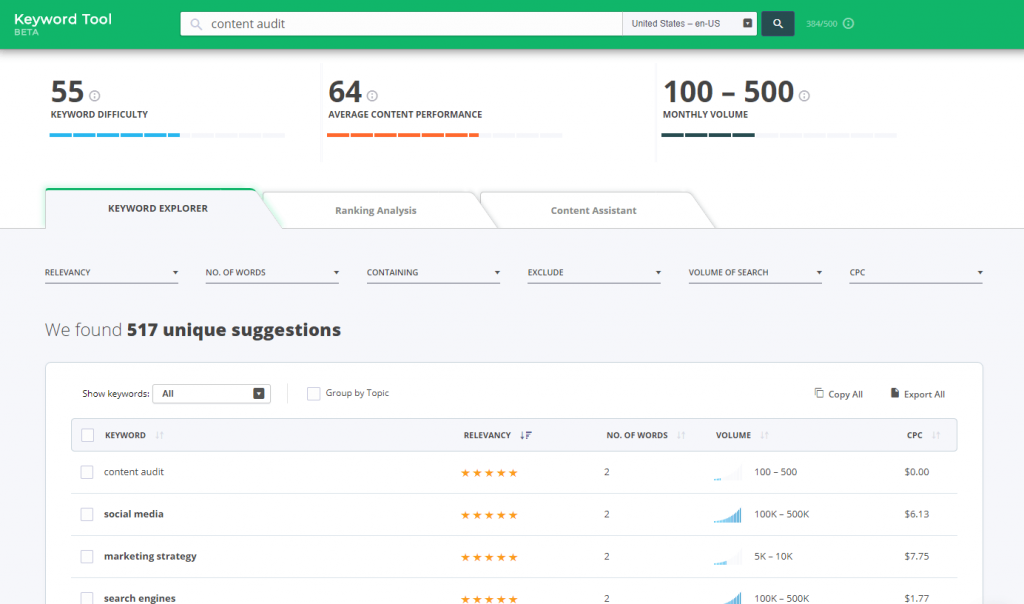
As you can see in the picture below, for our query “content audit” we have a 55 score for keyword difficulty, a 67 average performance score and 517 keyword suggestions. We looked through all of those and chose one or two keywords.
It is important to search for the same type of keywords. The tool categorizes the queries into brand, informational, and commercial. In our situation, we had an informative article, therefore the keyword was informational.
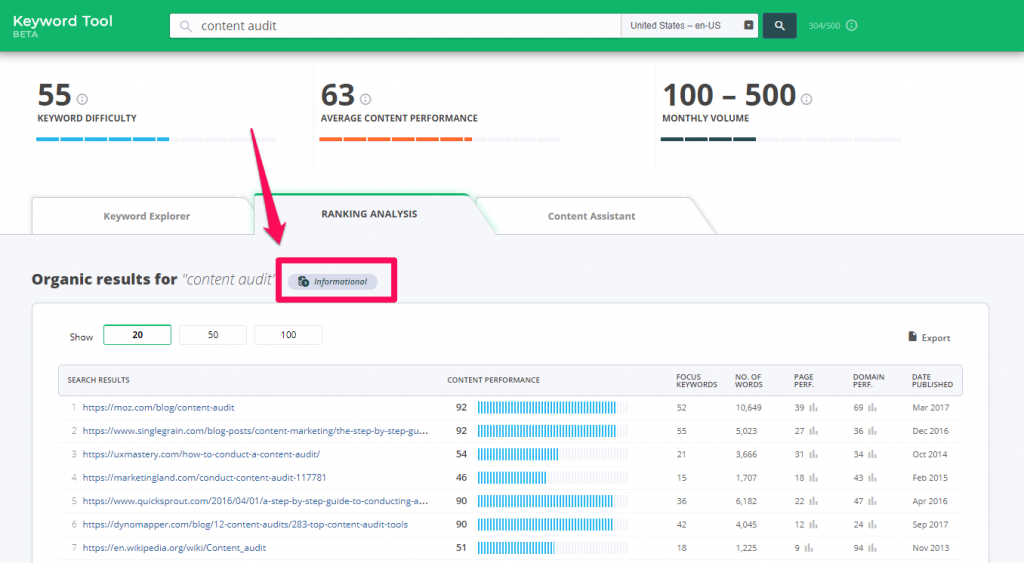
Step 2: Optimize the Content
Having those recommendations helped us to optimize the content for multiple keywords using the Content Assistant. This step is simple, just add the content in the special section, click on Check score and start analyzing it. We did this at first to see where we start from.
In our case, the article optimized for “content audit” had at first a performance score of 51.
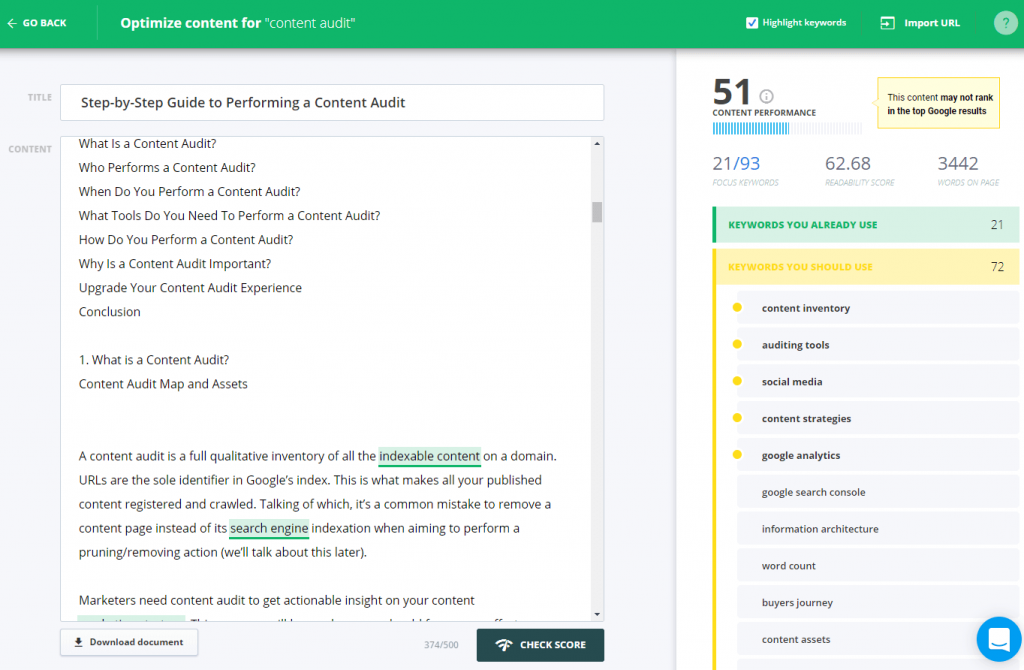
Before starting the optimization, we took print screens for all the keywords included in the research to spot exactly the ranking for each. At first, we ranked on the 36th position in google.com:
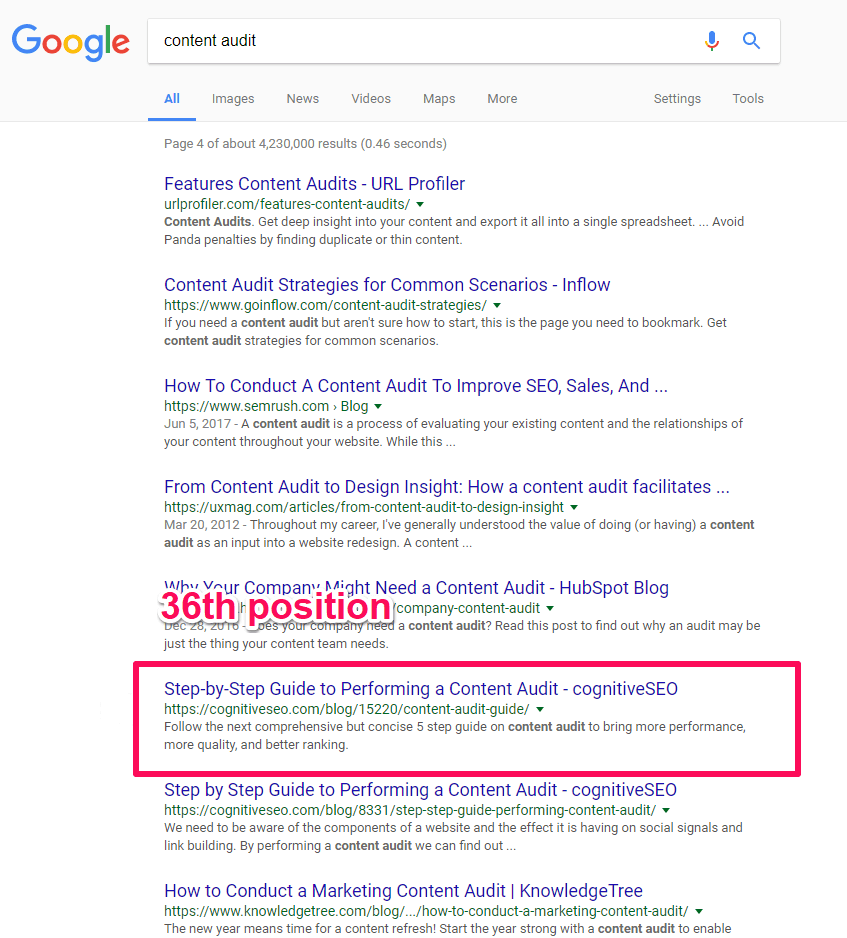
Afterwards, we added the keyword suggestions in context to increase the performance score. In the end, we checked the content score again to make a difference between the two situations. As you can see the next screenshot, the score was 92.
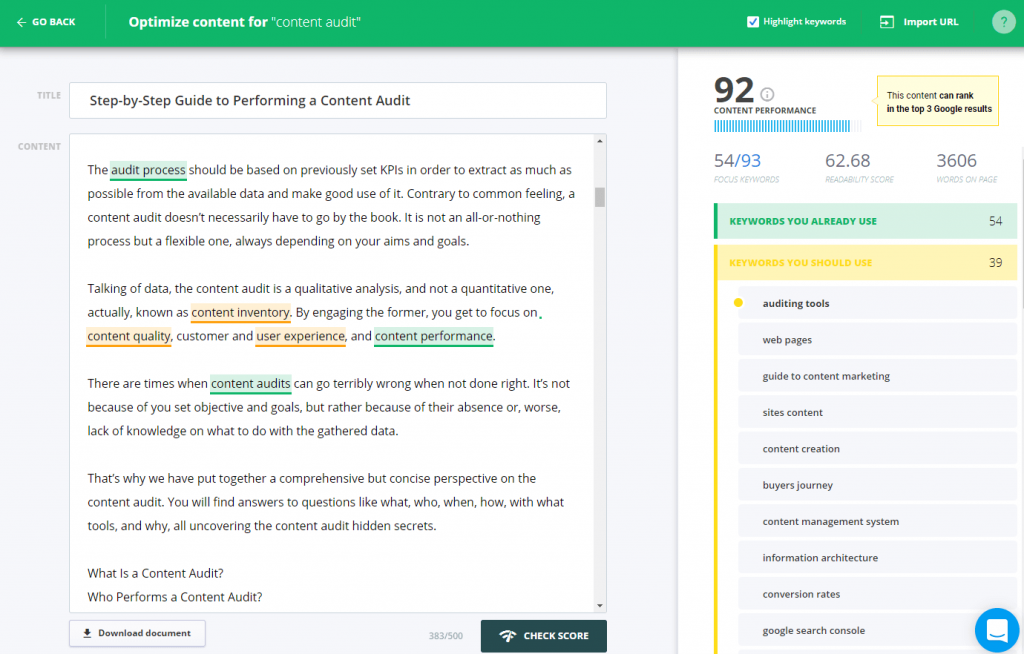
Step 3: Use Fetch as Google
The last step in our content optimization methodology was to send the new piece of improved content into Fetch as Google and keep an eye on the evolution it had in Rank Tracking.
We used this technique because we have a confirmed theory it worked for other specialists and experts in the field such as Bill Sebald, Jason Acidre and Krumel. After 10 weeks, we tested once again to see on which position we are placed for “content audit”.
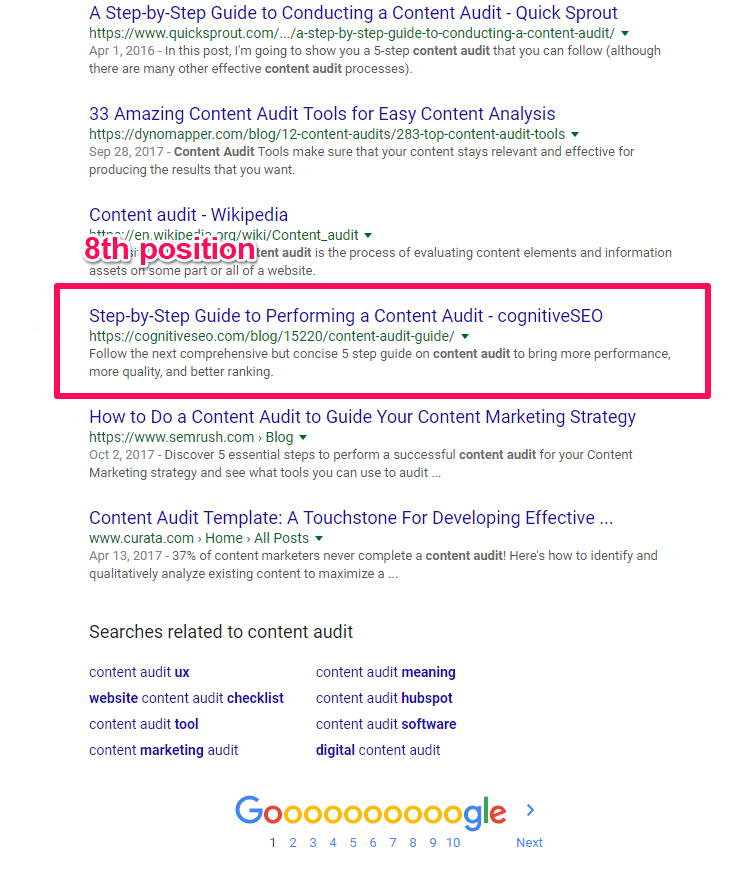
Coming from the 4th page on the 1st one after isn’t bad at all!
Except one single article, which suffered a major make-over (meaning changing meta description, title tags, structure), all the articles were optimized from a keyword point of view only. We didn’t change the cover photo or images to any of the blog post.
We added the keywords suggestions and that was it.
2. Case Study – Increasing Website Rankings by Smartly Optimizing Content
Specific Results
Taking our research further away, let me tell you what we discovered and what you can do to have a happy ending. The tracked keyword suffered some changes after our content optimization. There are 3 situations:
- Improvements;
- Nothing Changed;
- Decreases.
You can see it better, in the chart below:
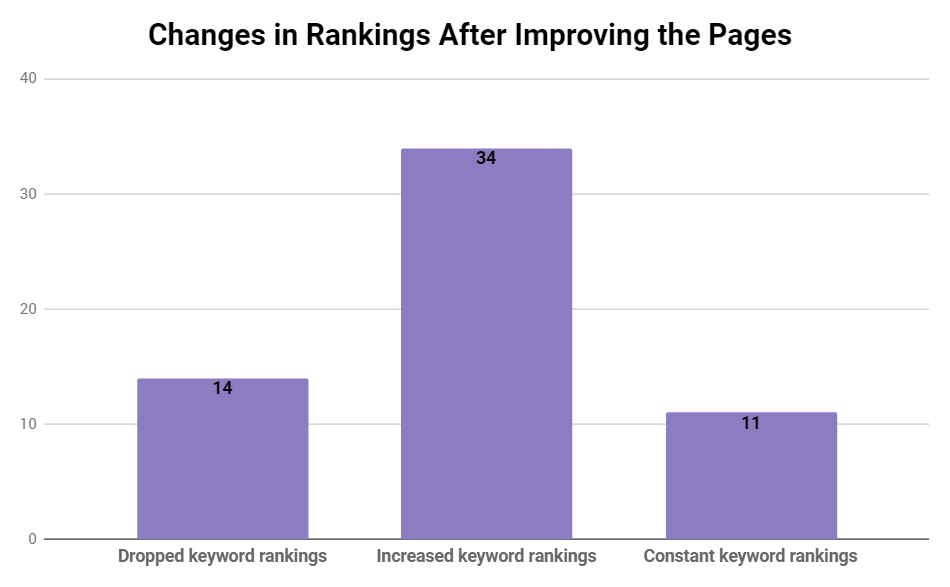
We had a high number of constant rankings. Sadly, we saw that a few keywords suffered a ranking drop and in most cases (13 out of 15) remained on the same page.
A lot of keywords (34 out of 59) had an improvement in rankings. But we had an interesting discovery, a keyword managed to increase 44 positions in Google (from 85 to 41).
From the Second Page on the First For “High-Quality Backlink”
Beautiful improvements with articles that jumped on the first page were “high-quality backlink” and “google fred”.
“High-quality backlink” had a content performance score of 35. And the page ranked on the 12th position in organic search results as you can see in the next screenshot:
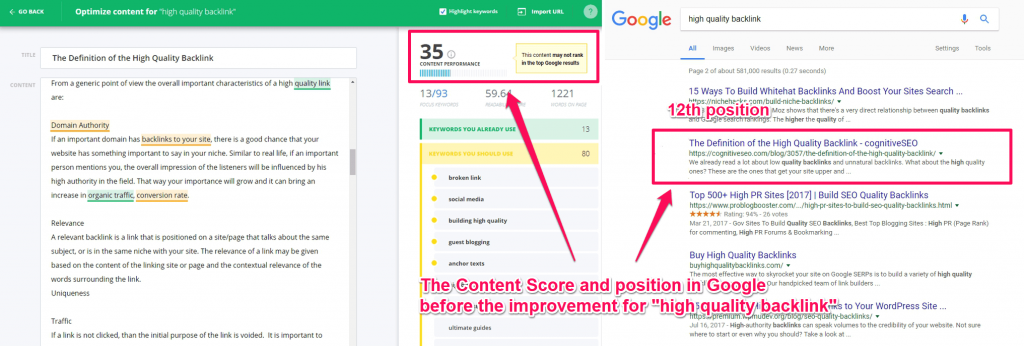
After following the process we mentioned before, the content ended up with a score of 76. Taking into consideration that the average score is 67, we managed to gain a good outcome. Hence the fact that now the page ranks on the 7th position in Google searches.
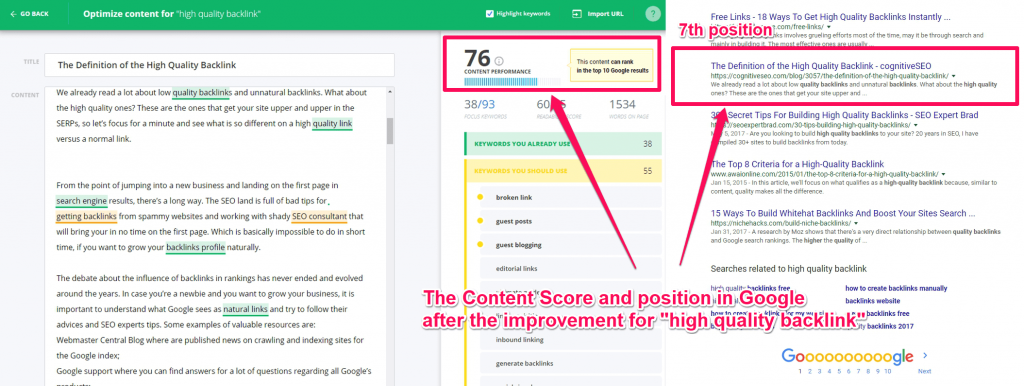
10 Positions Increase with a 10 Content Score Improvement For “Google Fred”
As mentioned before, the keyword “google fred” had a worth-mentioning improvement. It started with a high score, but even so it had few chances to rank on the first page as shown in the Content Assistant tool. Also, in the next screenshot we can see the actual position of the keyword.
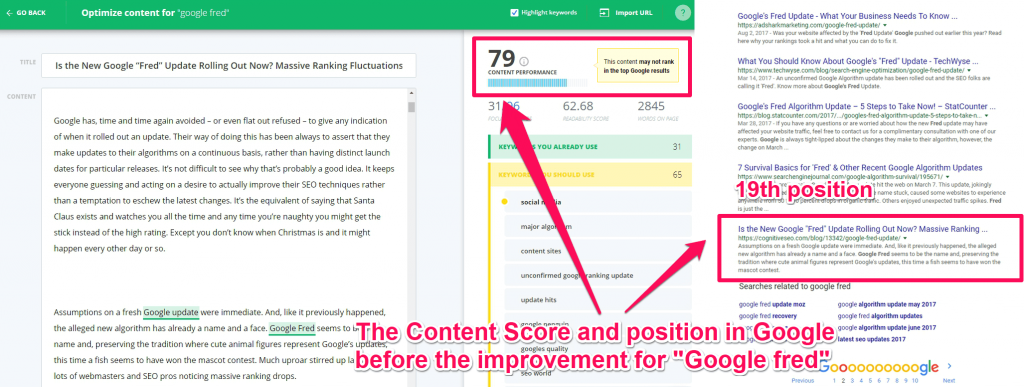
After we added some of the recommendations offered in the tool, we saw quite a nice comeback. A content score perfomance of 90 and the page positioned on the 9th place in Google.
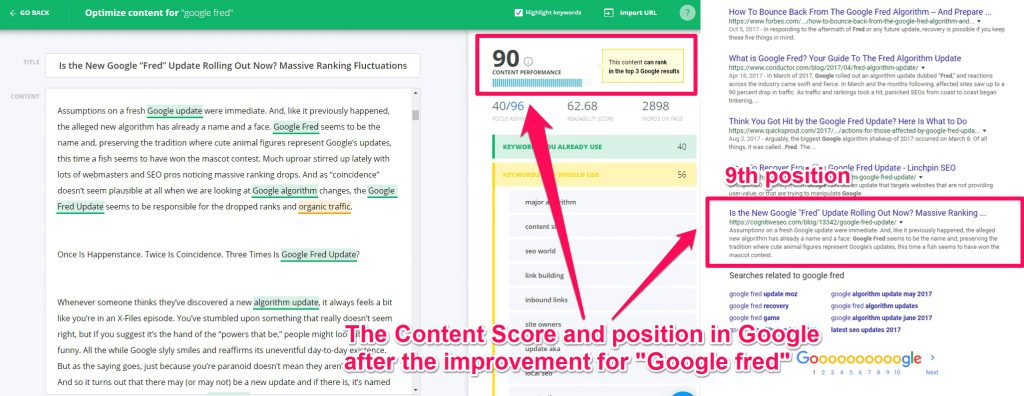
From Position 26 to Page 1 in Google for “SEO Term List”
Also, there were keywords that managed to have a huge improvement in rankings. Like the blog post we made the most changes (including meta description, title tags, structure). The keyword for this article is “SEO term list”. It started on the 26th position with a 68 content score.
This page suffered multiple changes, including URL and title optimization along the rest of the on-page SEO elements.
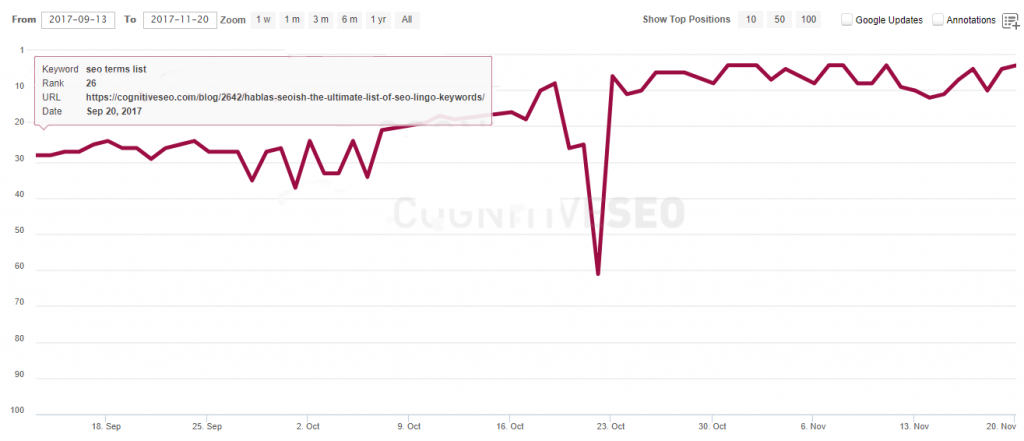
The page had a high content score of 68. And even so, we wanted to improve it because being a short tail keyword (don’t confuse it with longtail keywords) it had a high volume of searches and we could do much better. If there is room for improvement, we said “why not take it”?
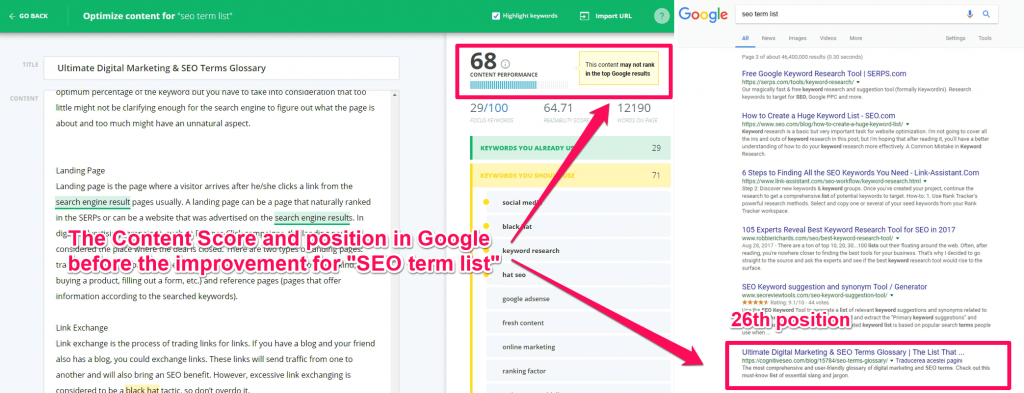
After the improvement, the content achieved a score of 100 and brought us on the first page. Jackpot!
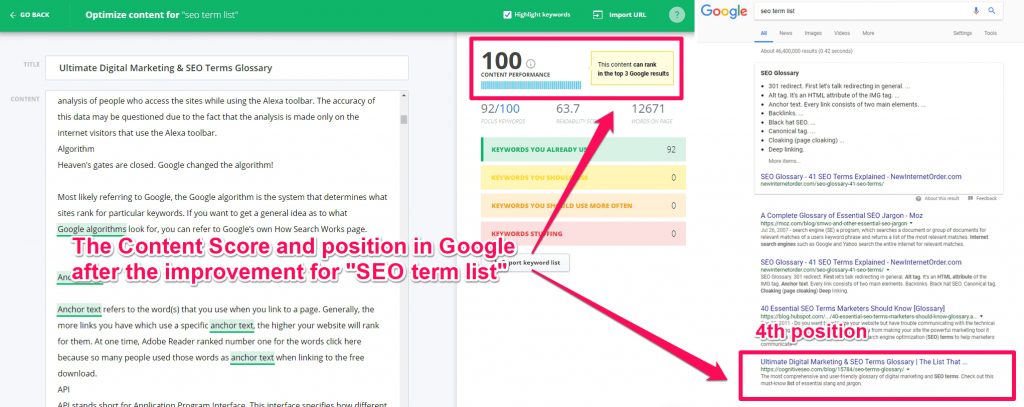
Some other keywords that had a beautiful improvement are: “keyword generation”, “evergreen content”, “content audit” (exemplified before at point 1).
In the next screenshot you can see the Content score performance and the position in Google for “keyword generation” before making any changes to the blog post.
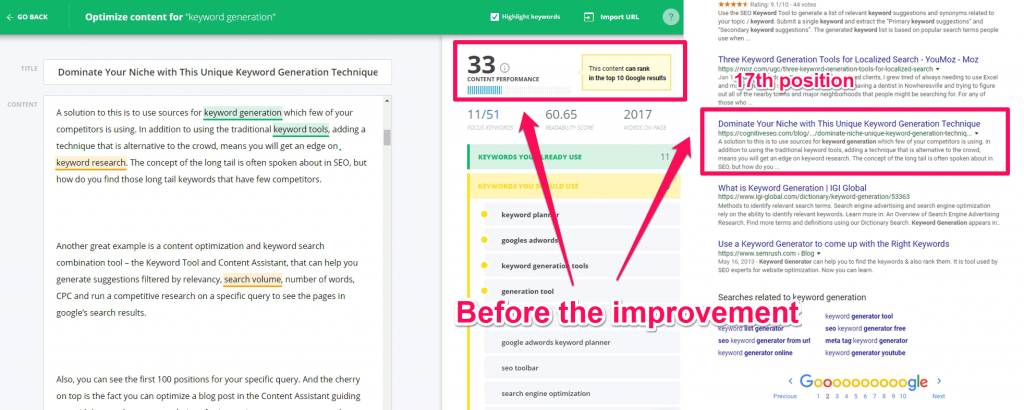
And below you can see how well is the page performing after the improvement for “keyword generation”.
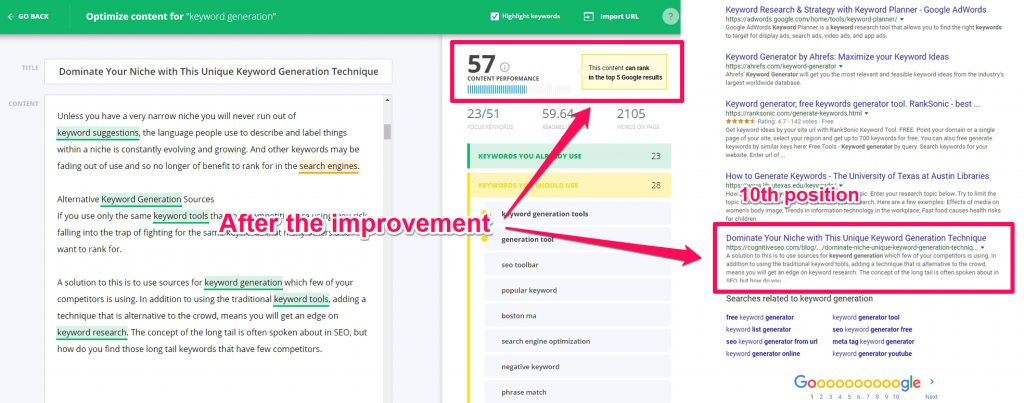
“Evergreen content” started on the 14th position with a 71 content performance score.
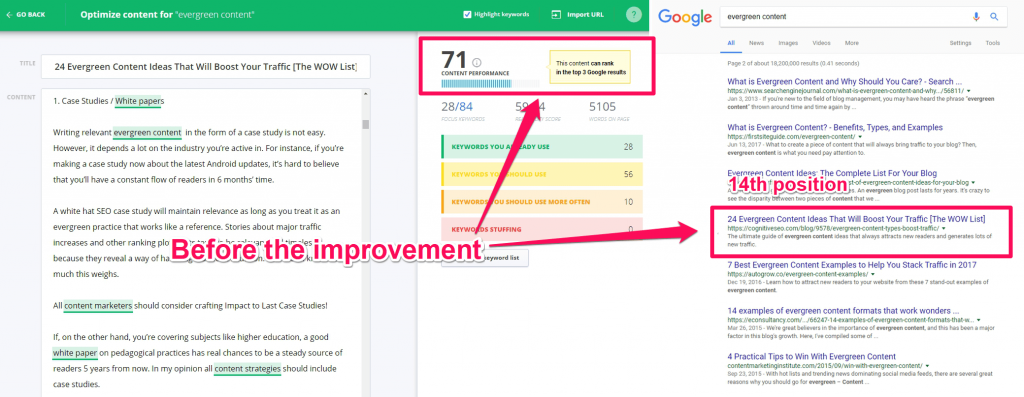
After the improvement, it jumped on the first page with the help of a 90 content performance score.
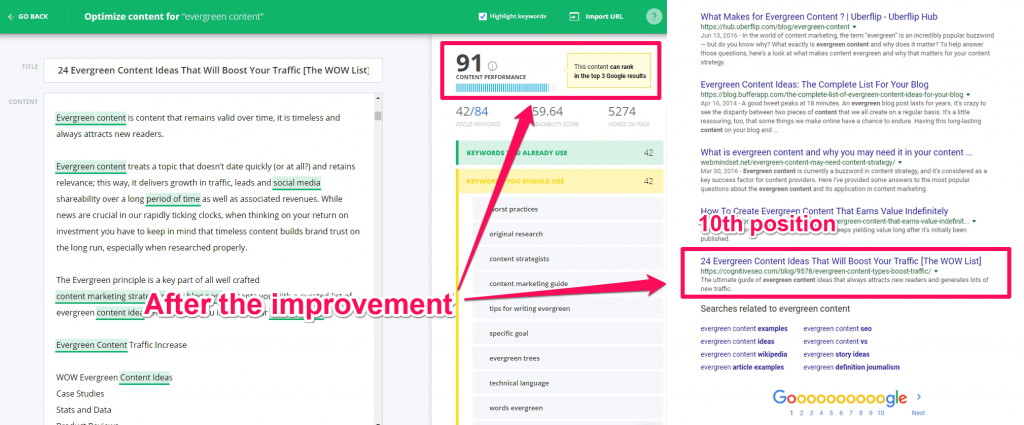
Constant Positions For “Local Link Building”
The keyword “local link building” had a content score of 54 and ended up to 90. The keyword ranked on the 11th position and we managed to get it on the 10th.
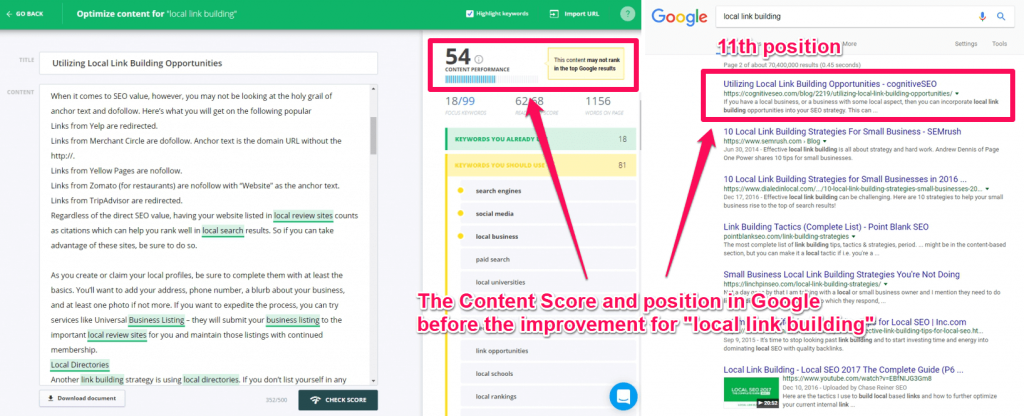
Not much, though, but it is on the first page now.
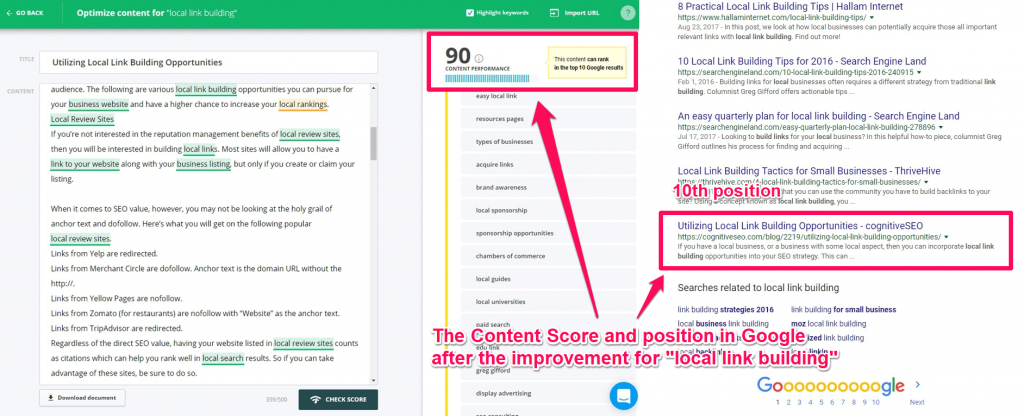
Some other keywords that had a constant improvement are: “social signals SEO”, “copywriting techniques”.
In the next screenshot you can see the Content score performance and the position in Google for “social signals SEO” before making any changes to the blog post.
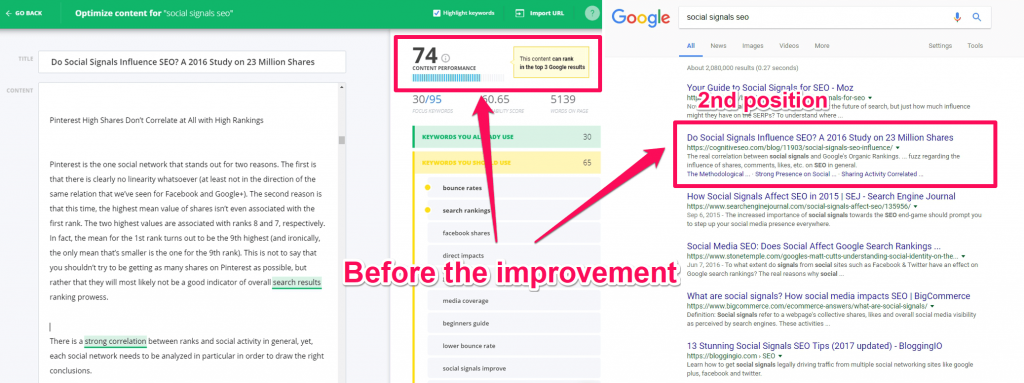
And below you can see how well is the page performing after the improvement for “social signals SEO”.
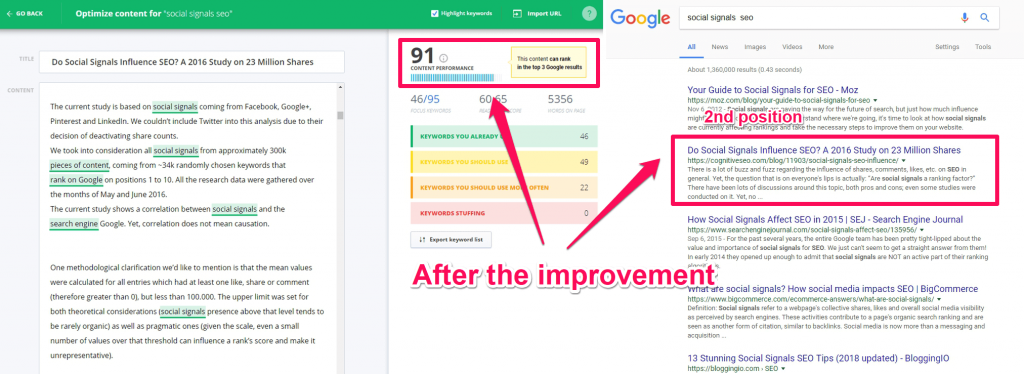
“Copywriting techniques” started on the 5th position with a 50 content performance score.
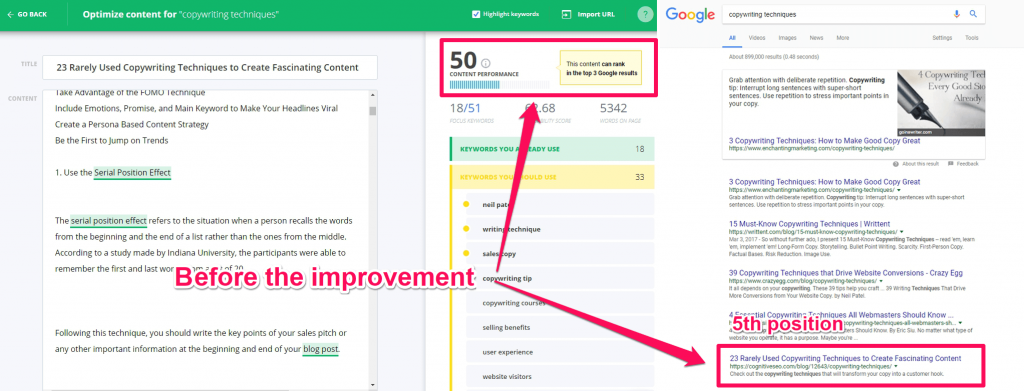
After the improvement, it remained on the same position with a 66 content performance score.

As you can see, somewhere around 25 October, the number of impressions and clicks started to increase. Except for using the Content Assistant tool and promoting our articles on our social media channel, we didn’t take any different actions (advertising or paid search).
Slight Drops on the First Page of Google for “Google Answer Box”
Slight drops on the first page of Google after optimization for “google answer box”. It started with a content performance score of 68 and on the 5th position.
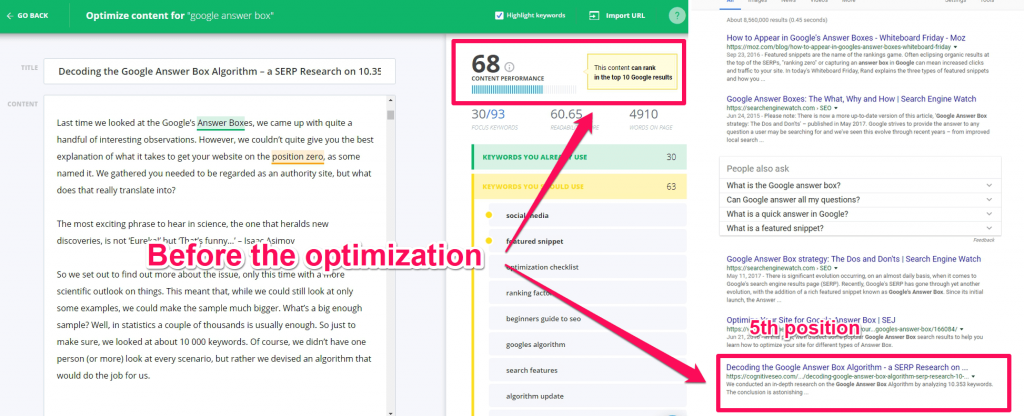
After the optimization, it ended with a content performance score of 90 and on the 9th position, unfortunately.

Some other examples of keywords that experienced a negative impact after improving the Content Score are “SEO mistakes” and “SEO on a budget”.
“SEO mistakes” started on the 17th position with a 78 content performance score.

After the improvement, it dropped on the 23rd position with a 90 content performance score.
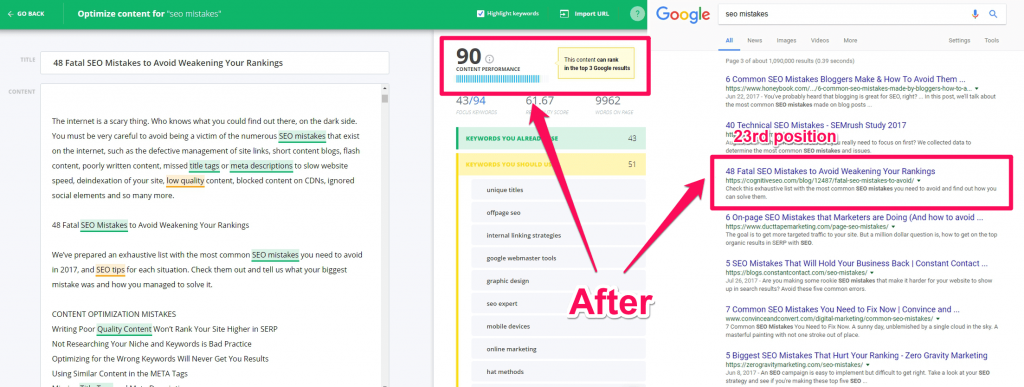
In the next screenshot you can see the Content score performance and the position in Google for “SEO on a budget” before making any changes to the blog post.
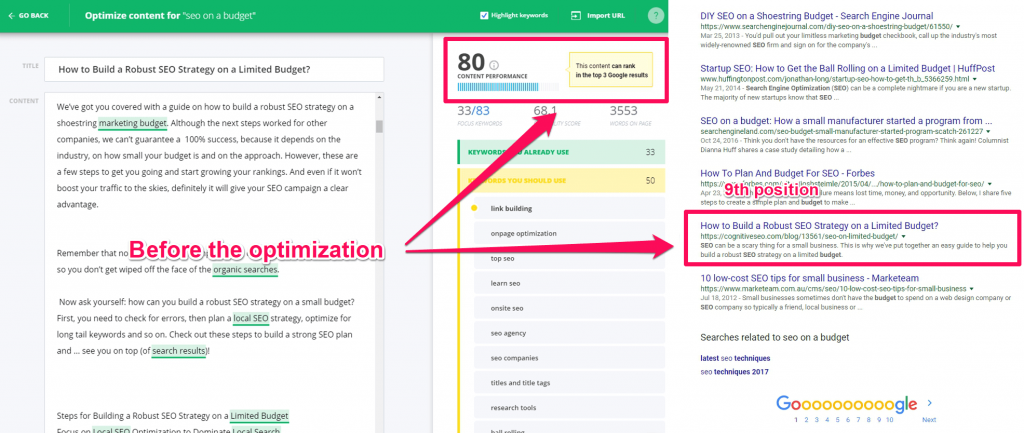
And below you can see the page dropped on the second page after the optimization for “SEO on a budget”.
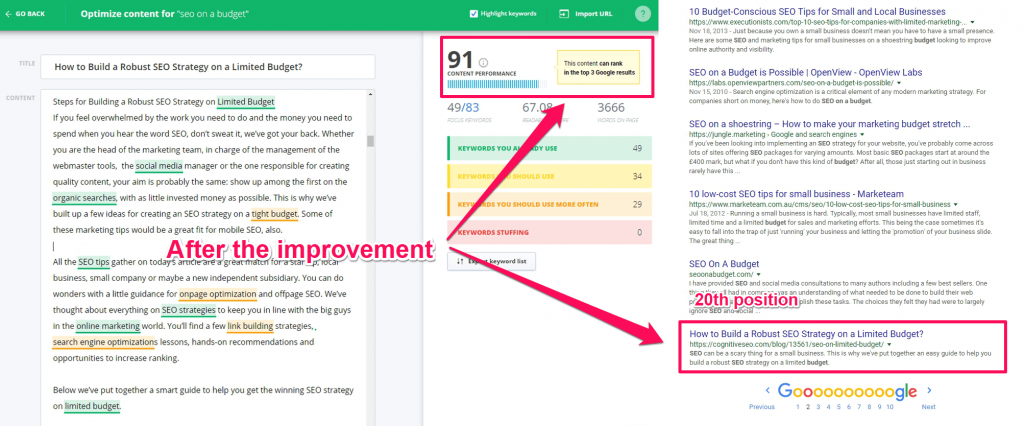
Another thing we’ve tested was multiple keyword optimization for a single page. We did that for most of our pages. And the results quickly started to appear.
In the next screen, you can see 3 trending lines for 3 keywords used for a single article we monitored before and after the optimization. They started on the positions 3, 10 and 20 and they managed to increase their rankings to 1, 8 and 16 position.
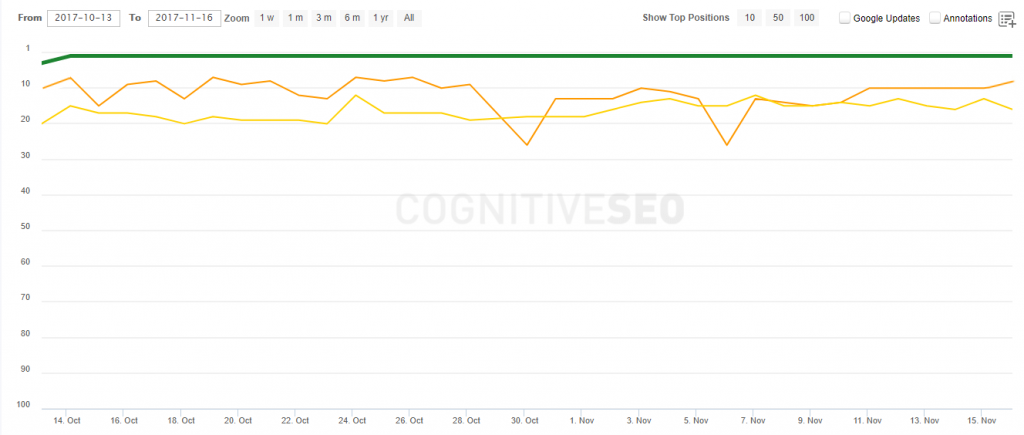
It’s not much, but due to this improvement, we saw a big increase in traffic in Search Console. This is the outcome:

Overall Results
Overall, the numbers were good:
- 14 declined rankings;
- 34 increase rankings;
- 11 constant rankings.
The keywords that were on the first 10 positions had little to no improvement, as you can see the next screenshot, but it’s good they didn’t fall on the second page. And most of them continued to receive a higher number of impressions.

Another discovery was the fact that 23 out of 25 keywords remained on the first page after the optimization and the rest of them ended up on the second page. If you take a look at the next screenshot you can see the evolution for some of them.
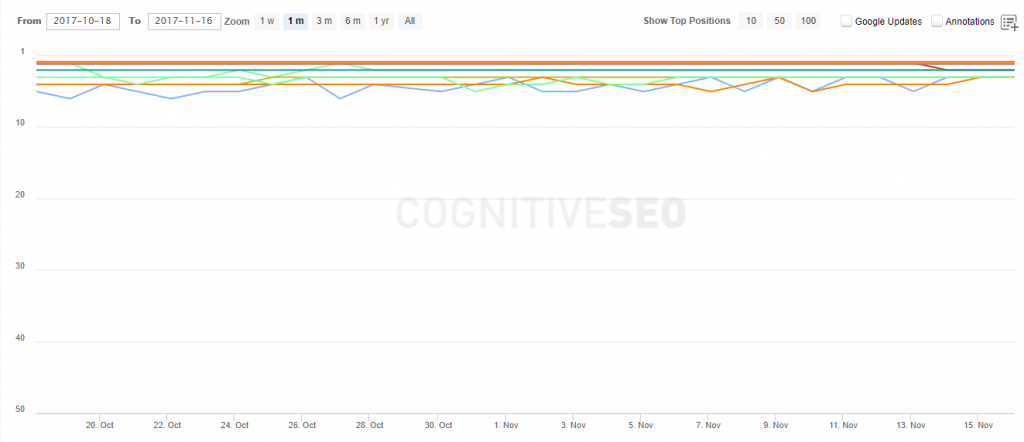
Unfortunately, some of the keywords experienced ranking drops. If you take a look at the next screenshot you can see at first the keyword had a drop and after that a fluctuant position in Google.
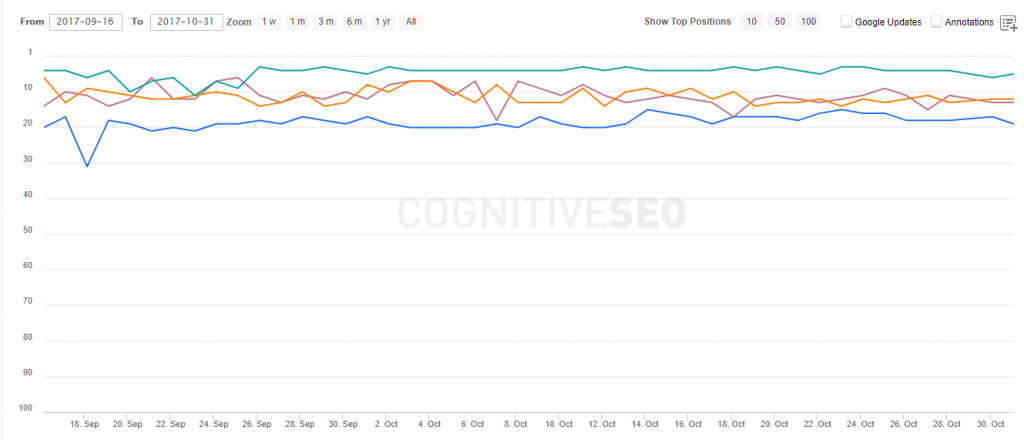
This kind of keywords are under the loop. We need to see exactly how they’ll evolve. Now, it is premature to take a conclusion and say exactly if they are indeed dropped.
Overall, the content optimization was a success. Our rankings improved and our traffic increased. After a quick search for our site in Site Explorer, you can see that starting with middle of September, our search visibility has had a beautiful growth:
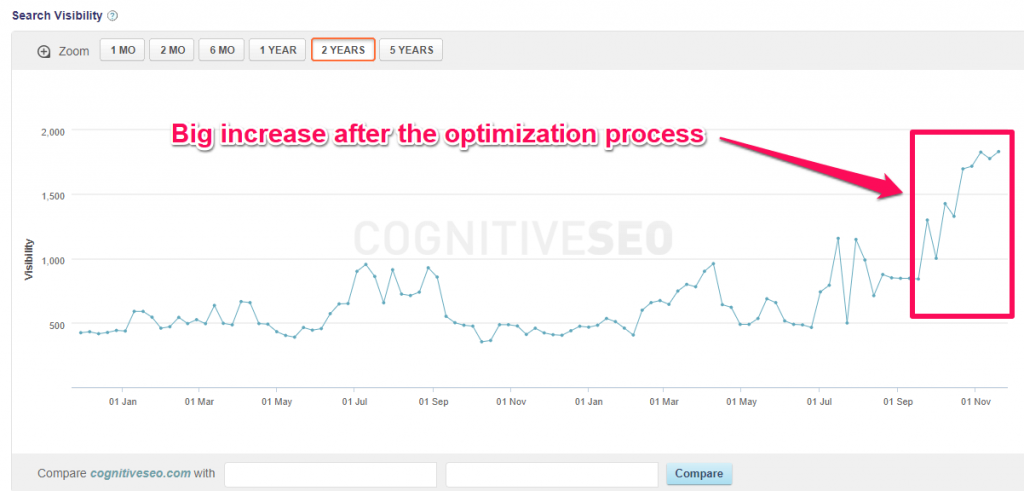
Source: https://explorer.cognitiveseo.com/?u=cognitiveseo.com&m=*U*#section/4
We started to optimize the pages on September 20. In the graphic, the trending line started to increase in the week between September 17 – 24. That explains the sudden boost.
We compared the results in SEO visibility for the same period in 2016 and in 2017, after the keyword improvement and we had an increase of 69,2%. Compared with the results we had after 10 weeks after the optimization (August 9 – September 10) we had an increase in rankings of 41%.
3. Google’s Opinion on Improving Content vs. Deleting Content
During a Webmaster Central Hangout, somebody asked what’s the best approach to deal with low-quality content.
John Mueller gave an explanation on what Google considers to be low-quality content:
| In general, we evaluate a site as having low-quality content when we see it is providing something that is not fantastic. | |
| JOHN MUELLER | |
| Webmaster Trends Analyst at Google / @JohnMu | |
There are 2 situations approved by quality engineers to tackle low-quality content:
- You can improve your content. John Mueller says this is the best approach.
- In case you can’t improve the quality of the content because it’s too big, it’s auto-generated or some other reason, it makes more sense to clean it up.
John Mueller says both are valid strategies, but he encourages webmasters to improve the content, if possible. Improving is probably the best practice because it creates extra value for your website. On top of that, it is easier to add content and improve it and boost your search rankings. Optimizing your site may be easier because that content has already been indexed in Google. This way you can send signals to Google that your content is valuable and you add new information to update pages on your site.
4. Content Performance Solution for Unlocking the Access to Higher Rankings
Content has started to get more and more attention in the past years. We keep talking about content as a Google ranking factor.
Andrey Lipattsev, Search Quality Senior Strategist at Google, said during a Q&A session that between link and RankBrain, content is in top three ranking factors.
You can follow the conversation in the next video at 30-minute mark:
Since content is an important signal that contributes to results, we created a tool that can help webmasters build better content. Hence the Content Performance Score, the guide that gives a clue on how far or near you are to get on the first page. Improving your Google ranking positions got more accessible with the help of the tool.
Using the tool is easy and the metric is highly intuitive. In the next snippet, you can see a preview of the results triggered after analyzing the content in the Content Assistant tool.
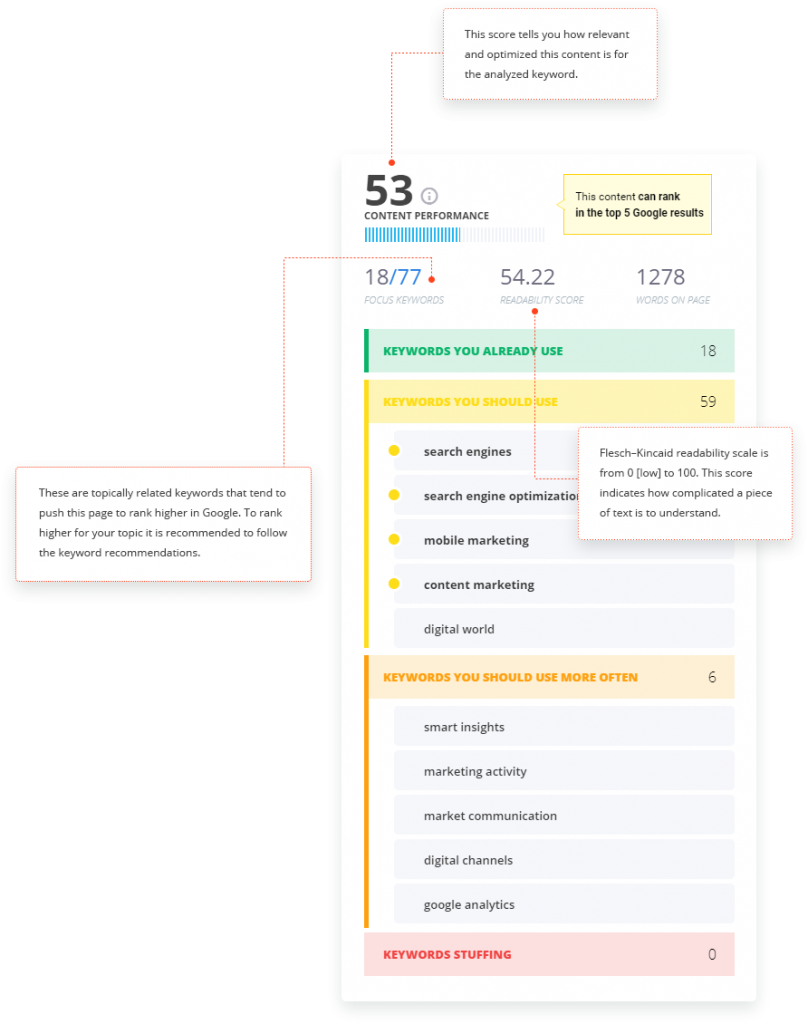
We used the tool and looked for achieving the highest Content performance. Take, for example, the score for the “local link building” keyword. Af first, it was 54.
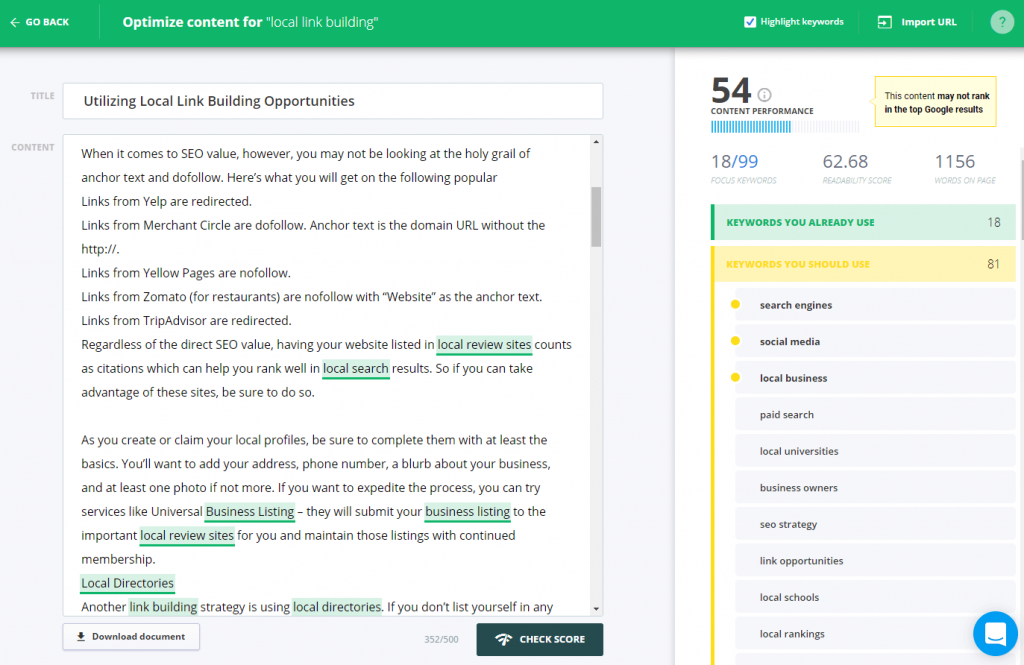
And we got to raise the content score up to 90. We added mostly suggestions from the “Keywords you should use” section and then we added some from the “Keywords you should use more often” category. This way you get a chance to improve Google rankings.
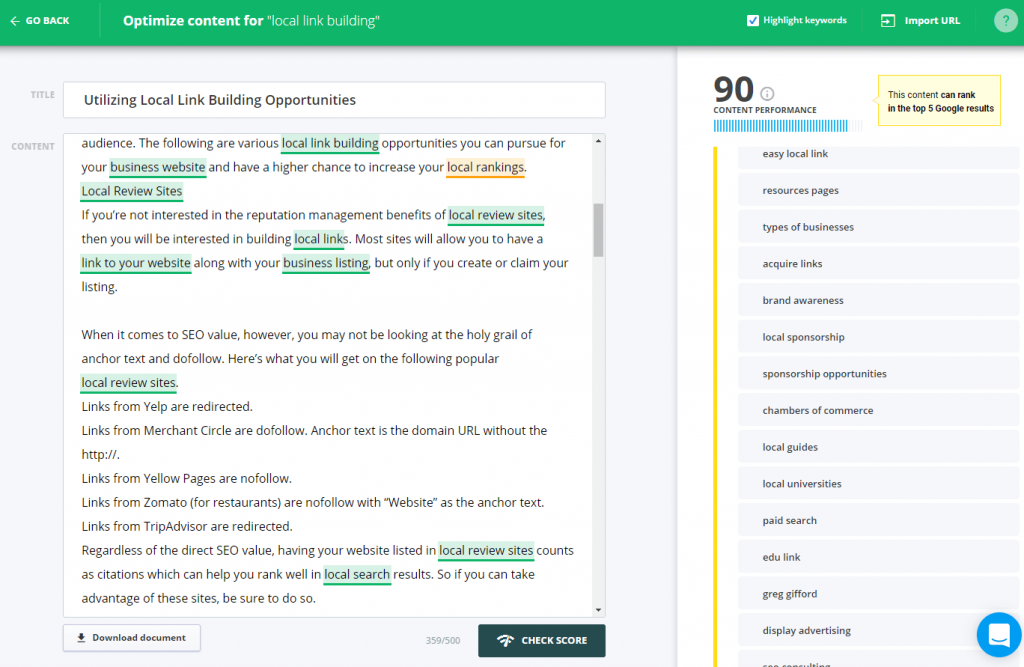
The content performance score will notify you if you have a chance to rank, as you can see in the pictures above.. You can see the yellow balloon message that says: “This content may not rank in the top Google results” and “This content can rank in the top 5 Google results”.
Conclusion
By means of this article we got to answer ourselves some questions, such as: is it ok to optimize a page if it already is on the first position, is it ok to optimize my page for multiple keywords and will this bring be a traffic increase?
The answer to all of these questions is yes. And that’s because even though you have a high score performance and you rank on the first page, if the keyword is a short tail type, as it was in our case, the competition is very high and it is better to have the best content for it to increase your chances to get featured in SERP.
It is ok to optimize a single page with multiple keywords because this will bring you a higher volume of searches and improve your website ranking, broadly speaking. And this can lead to a traffic increase.
We lost some, but we won many more. Overall, our experiment has had a positive impact on the whole website. If you follow our steps and tips to improve your content, you’ll have the pleasant surprise of increasing your rankings and, why not, the traffic to your website.
The post 70% SEO Visibility Increase by Doing Content Optimization appeared first on SEO Blog | cognitiveSEO Blog on SEO Tactics & Strategies.
70% SEO Visibility Increase by Doing Content Optimization posted first on http://nickpontemarketing.tumblr.com/
No comments:
Post a Comment